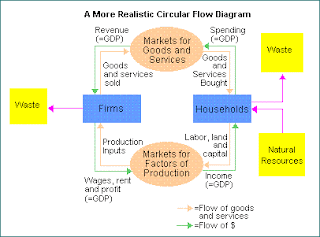I'm taking a Macroeconomics class this semester as well, which is sort of challenging to absorb alongside all these critiques of the system that it focuses on. The material being so fresh, I frequently find myself contrasting what I'm learning about the way the market is supposed to work with what we're discussing in this class about how it actually has worked and how it might be made to work differently. This week, that clash was particularly sharp when Meadows introduced her flow diagrams: they recalled a figure from my economics text (which I found in a slightly altered version on Lewis & Clark College's website) that portrayed the flow of money through a market economy as it was exchanged for goods and services, labor and production.

It seems so elegant as presented. The more people spend, the more firms produce, and the more people get paid in turn for their labor or investment! The faster those arrows whip around, the better off everyone would seem to be -- as McDonough writes, "GDP takes only one measure of progress into account: activity." (36) Yet as we're learning, the center somehow cannot hold. What is it about this accounting that creates the impression of sustainable reciprocation and masks the loss of "human and ecological health, cultural and natural richness, and even enjoyment and delight"? (43) Maybe applying systemic thinking to the problem will reveal its weakness.
According to Meadows, a system consists of elements, interconnections, and purpose. For the diagram above, we can see that the elements are the capital stocks of firms and households as well as the markets to exchange them; the interactions are of course those exchanges of wealth, goods and services. The function, ostensibly, is to enable people access to goods and services they could not otherwise provide for themselves; as Wessels discussed in the Myth of Progress however, this has become equated in neoclassical economics with constant growth. Since there are no inflows or outflows documented here, we might wonder how the economy is supposed to increase in size by building only on the materials it is already comprised of. Perhaps it swells like a balloon, stretching itself thin and empty to increase in circumference -- of course, balloons can only be inflated to a certain point before they pop.
Perhaps it was fatuous to ignore the "land and capital" ascribed as possessions to household units, but it was in service of a point. The diagram above assumes the availability of a stock of natural resources in the system but doesn't address their provenance. Similarly, it eliminates the concept of waste (albeit in a much different sense than do McDonough and Braungart). If we were to represent these in- and outflows in the diagram, we could better conceive of our economic system as part of -- rather than separate from -- the biosphere and its resources.

I say "part of... its resources" because it allows for the possibility suggested in Cradle to Cradle that human endeavor could actually contribute to environmental quality. I haven't done away with waste in my diagram, however, because I intend it to reflect things as they are currently. Meadows writes that "as long as the sum of all inflows exceeds the sum of all outflows, the level of the stock will rise," which means that for the economy to perform its function as described by Wessels -- that is, for it to grow ever larger -- the consumption of natural resources needs to be faster than the generation of waste. (22) That is, the taps need to be flowing faster than the drain. We tend to consider the inflow more than the outflow, which means that to keep those economic arrows spinning around we adopt policies and practices that cause us to consume more and have little concern for the waste we generate as long as it's less than the harvested natural capital.
Braungart and McDonough, in their cradle-to-cradle model, would focus more equally on the waste side of the equation to keep the economic bathtub full. Better design, they suggest, can make manufactured products not just less useless at the end of their lives, but actually integral parts of some other industrial or biological process. Making more thorough use of the material and energy we extract from our natural environment can lead us to waste less (theoretically to waste nothing) while maintaining stocks of wealth and quality of life previously sustained through the brute force method of massive inflow. With that in mind, let's reconsider the stated purpose of the economic system above: to enable access to goods and services.
What is it that hinders such access? Is it a dearth of technology, labor, production or extraction capacity? Or is it that, despite our eagerness and ability to consume we are running into natural limits like the amount of carbon that can be processed by the environment or the worldwide arable acreage? Is there something wrong with our bathtub, or have we just opened the taps as wide as they'll go? Maybe we should use some sort of grey water treatment to reclaim some of the gallons swirling down the drain. Cradle to cradle design incorporates some of the most important insights of systems thinking toward some of the most important goals outlined in The Myth of Process.
No comments:
Post a Comment